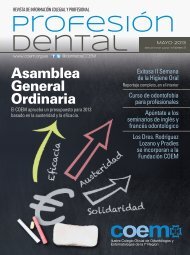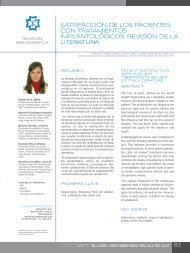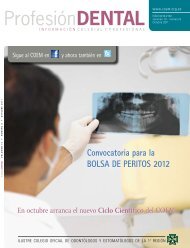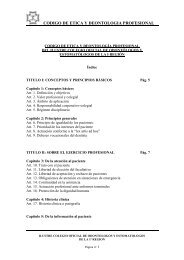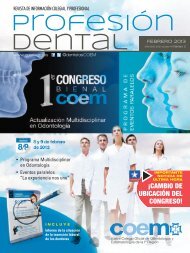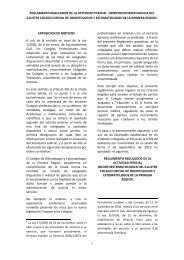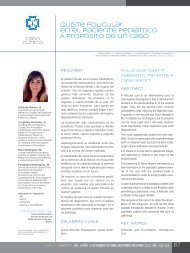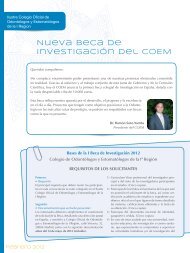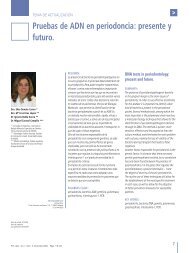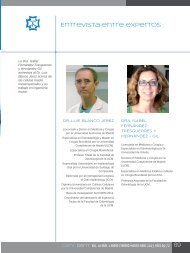Cientifica dental VOL 9-1_MaquetaciÃn 1 - COEM
Cientifica dental VOL 9-1_MaquetaciÃn 1 - COEM
Cientifica dental VOL 9-1_MaquetaciÃn 1 - COEM
Create successful ePaper yourself
Turn your PDF publications into a flip-book with our unique Google optimized e-Paper software.
Artículo<br />
Original<br />
XIV PREMIO CIENTÍFICO ANUAL<br />
PROF. DR. D. PEDRO<br />
RUIZ DE TEMIÑO MALO<br />
Morfología interna del primer molar mandibular<br />
permanente. Influencia del uso de ultrasonidos y<br />
del microscopio operatorio en la localización de<br />
conductos<br />
Valencia de Pablo, Ó. Pérez Zaballos, MT. Péix Sánchez, M. Estévez, R. Cisneros, R. Morfología interna del primer molar mandibular permanente.<br />
Influencia del uso de ultrasonidos y del microscopio operatorio en la localización de conductos.<br />
Cient. Dent. 2012; 9; 1.<br />
Valencia de Pablo, Óliver<br />
Odontólogo. Profesor del Máster<br />
en Endodoncia Avanzada,<br />
Universidad Europea de Madrid.<br />
Pérez Zaballos, María<br />
Teresa<br />
Médico Estomatólogo. Profesora<br />
de la Universidad de Salamanca,<br />
Departamento de Anatomía.<br />
Péix Sánchez, Manuel<br />
Médico Estomatólogo. Profesor<br />
de la Universidad de Salamanca,<br />
Departamento de Endodoncia.<br />
Estévez Luaña,<br />
Odontólogo, Roberto<br />
Odontólogo. Profesor del Máster<br />
en Endodoncia Avanzada,<br />
Universidad Europea de Madrid.<br />
Cisneros Cabello, Rafael<br />
Médico Estomatólogo. Director<br />
del Máster en Endodoncia<br />
Avanzada, Universidad Europea<br />
de Madrid.<br />
Indexada en / Indexed in:<br />
- IME<br />
- IBECS<br />
- LATINDEX<br />
- GOOGLE ACADÉMICO<br />
Correspondencia:<br />
Óliver Valencia de Pablo<br />
Avenida de Bruselas, 64, 6º2<br />
28028 Madrid<br />
Tfno.: 630103528<br />
Email: olileon2001@yahoo.es<br />
RESUMEN<br />
Introducción: Estudios recientes reflejan la<br />
existencia de conductos accesorios en las<br />
raíces de los primeros molares permanentes<br />
inferiores. El objetivo principal de este trabajo<br />
es determinar la influencia que tienen el<br />
uso de ultrasonidos y el microscopio operatorio<br />
en la localización de dichos conductos.<br />
Como objetivo secundario, hemos empleado<br />
la técnica de diafanización de manera innovadora<br />
para visualizar la anatomía real de<br />
los molares inferiores tratados.<br />
Metodología: Se realizó la apertura de 53<br />
primeros molares permanentes inferiores en<br />
varias fases, anotando el número de conductos<br />
localizados en cada una de ellas. La<br />
primera, sin magnificación ni ultrasonidos. A<br />
continuación se incorporaron la puntas ultrasónicas<br />
y, en una tercera fase, se añadió el<br />
microscopio operatorio. Finalmente se utilizó<br />
la técnica descrita por Robertson para diafanizar<br />
los dientes y describir sus sistemas de<br />
conductos mediante la clasificación de Vertucci,<br />
modificada por diversos autores.<br />
Resultados: Tanto el uso de ultrasonidos<br />
como del microscopio operatorio, aumentaron<br />
el número de conductos localizados,<br />
pero las diferencias sólo fueron estadísticamente<br />
significativas con el uso simultáneo<br />
de ambos. Su ayuda fue más importante en<br />
la raíz mesial que en la distal. Un 26.4% de<br />
las raíces mesiales presentaba tres orificios<br />
de entrada a la cámara pulpar, cuyas configuraciones<br />
hacia la zona apical son<br />
Internal morphology of the<br />
mandibular first permanent<br />
molar. Influence of the use of<br />
ultrasonic tips and operating<br />
microscope in locating canals.<br />
ABSTRACT<br />
Introduction: Recent studies reflect the<br />
existence of accessory canals in the roots of<br />
the first lower permanent molars. The main<br />
objective of this paper is to determine the<br />
influence that the use of ultrasonic tips and<br />
the operating microscope have in locating<br />
these canals. As a secondary objective, we<br />
have used the clearing technique in an innovative<br />
way to visualize the actual anatomy of<br />
the treated lower molars.<br />
Methodology: The access cavities of 53 first<br />
lower permanent molars were done in<br />
different phases, noting the number of<br />
canals located in each of them. The first,<br />
without magnification or ultrasound. Next the<br />
ultrasonic tips were incorporated and, in a<br />
third phase, the operating microscope was<br />
added. Finally, the technique described by<br />
Robertson was used to make the teeth<br />
transparent and describe their root canal<br />
systems by means of the Vertucci’s<br />
classification, modified by various authors.<br />
Results: Both the use of ultrasound and the<br />
operating microscope increased the number<br />
of located canals, but the differences were<br />
only statistically significant with the<br />
cient. dent. <strong>VOL</strong>. 9 NÚM. 1 ABRIL 2012. PÁG. 00 7



